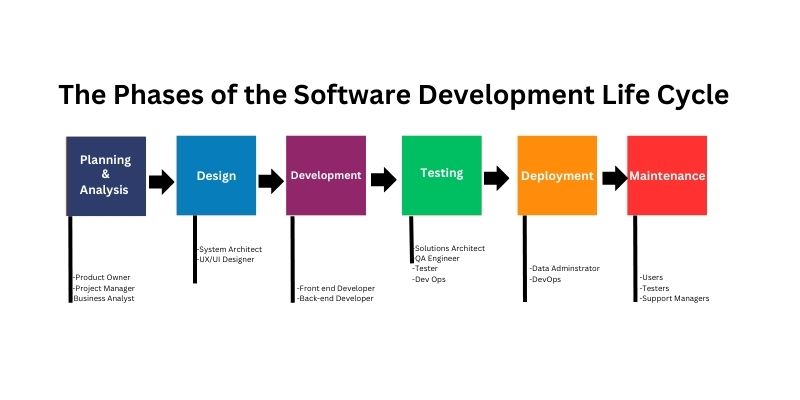We all know that not every company that needs a tech team is a technology company. And not every technology company is made up of only techies. Right? The reality is often far from the expectation. The truth is many CEOs (and hiring managers) aren’t “fluent” in tech—their expertise lies with other things…like steering the company’s direction or planning for growth.
However, with digital transformation no longer optional, grasping the essentials of software development has become a critical skill for businesses across all sectors.
So, if you happen to be one of those who secretly want to stop the TPM in the middle of a Monday meeting and say, “Wait, what is a Software Development Life Cycle?” Don’t worry – we are here to help!
Let’s break it down…
What is a Software Development Life Cycle?
The Software Development Lifecycle (SDLC) is a structured process that guides the creation of software applications from initial conception to deployment and maintenance. It’s designed to ensure that software is developed systematically, meets user needs, and is delivered on time and within budget. In a nutshell, the SDLC provides a framework for managing the complexities of software development, which ultimately promotes efficiency and collaboration among teams.
Understanding this cycle is crucial for several reasons:
- Resource Allocation: It allows for better planning and distribution of human and financial resources across different stages of development.
- Risk Management: By following a structured process, potential risks can be identified and mitigated early in the development process.
- Quality Assurance: A well-implemented cycle includes robust testing and quality control measures, ensuring the final product meets the required standards.
- Stakeholder Communication: It provides a common language and framework for all stakeholders, from developers to executives, facilitating clearer communication.
- Strategic Hiring: Knowledge of the cycle helps in identifying the specific skills and roles needed at various stages, leading to more strategic hiring decisions.
Got your attention yet? Let’s move on to the actual phases.
The Phases of a Software Development Life Cycle
The Software Development Lifecycle (let’s just stick with SDLC) consists of several distinct phases, each with its own set of tasks and objectives. Below I will break down these phases and consider how nearshoring can support each stage:
- Planning: This initial phase defines the project’s scope, goals, and feasibility. It involves gathering requirements from stakeholders and creating a project plan that outlines resources, timeline, and budget. Nearshore project managers can help facilitate this process, ensuring clear communication between stakeholders and the development team.
- Analysis: Detailed requirements of the software are gathered and analyzed in this phase. This includes creating specifications that describe what the software will do and how it will perform. Nearshore business analysts can bridge the gap between business needs and technical solutions, ensuring accurate requirement gathering.
- Design: The software’s architecture and design are created based on the specifications from the analysis phase. This includes designing the user interface, system architecture, and database structure. Nearshore software architects and UX/UI designers can contribute their expertise to create robust and user-friendly designs.
- Implementation (or Coding): This is where the actual coding happens. Developers write the code based on the design documents, creating the functional elements of the software. Nearshore developers, whether front-end, back-end, or full-stack, can work collaboratively with your in-house team to bring the design to life.
- Testing: Once coded, the software undergoes rigorous testing to identify and fix any bugs or issues. Testing ensures that the software works as intended and meets all requirements. Nearshore QA engineers can conduct thorough testing, ensuring the quality of the final product.
- Deployment: The software is released to users in this phase. This may involve installing the software on user devices, making it available for download, or deploying it on a web server. Nearshore DevOps engineers can manage smooth deployments and ensure system stability.
- Maintenance: After deployment, the software enters the maintenance phase, where it is monitored for any issues or bugs that may arise. Updates and improvements are made as needed. Nearshore support teams can provide ongoing maintenance and updates, ensuring the longevity and continued performance of your software.
There are some additional important steps to take as well:
- User experience testing: In order to ensure that the software meets the needs and expectations of its users, it is important to conduct thorough user experience testing. This involves gathering feedback from real users and making any necessary changes or improvements based on their input.
- Performance testing: Another important step in software development is performance testing. This involves measuring the speed, stability, and overall performance of the software under various conditions. Nearshore DevOps engineers have extensive knowledge and experience in conducting these tests to ensure that your software runs smoothly and efficiently.
And last, but certainly not least:
- Security testing: With cyber-attacks becoming increasingly common, it is essential to conduct security testing on your software to identify any vulnerabilities or weaknesses. Nearshore teams can perform rigorous security tests using advanced tools and techniques, providing you with peace of mind.
Key Roles in a Software Development Life Cycle
Each stage of the cycle requires specific skills and expertise. Understanding these roles can help you know how to build a balanced and effective development team. Let’s go over them:
- Project Manager: Oversees the entire project, ensuring it stays on schedule, within budget, and meets objectives. They coordinate between different team members and stakeholders.
- Business Analyst: Bridges the gap between business needs and technical solutions. They gather and document requirements, ensuring the final product aligns with business goals.
- Software Architect: Designs the overall structure of the software system, making high-level design choices and dictating technical standards.
- Frontend Developer: Specializes in creating the user interface and user experience of the software. They work with languages like HTML, CSS, and JavaScript.
- Backend Developer: Focuses on server-side logic, databases, and application integration. They typically work with languages like Python, Java, or Ruby.
- Full-Stack Developer: Capable of working on both frontend and backend development, providing versatility to the team.
- Quality Assurance (QA) Engineer: Responsible for testing the software at various stages to ensure it meets quality standards and functions as intended.
- DevOps Engineer: Combines software development and IT operations, automating and streamlining the integration and deployment processes.
- UX/UI Designer: Focuses on creating intuitive, efficient, and enjoyable user experiences and interfaces.
Related Post 👉 Top 5 Soft Skills to Look for When Hiring Remote Developers
The Nearshoring Advantage in Software Development
It’s important to note that all the roles involved in this process can be effectively filled through nearshoring. Nearshoring involves partnering with professionals in nearby countries, often in similar time zones. This approach offers numerous benefits, including access to a larger talent pool, cost-effectiveness, and cultural affinity. It allows businesses to quickly scale their development capabilities, fill skill gaps, and stay competitive in rapidly evolving markets.
Plugg Technologies, for instance, specializes in Latin American nearshore staffing, offering expertise in finding the right team for your business needs. By leveraging nearshore options, companies can build robust, flexible development teams that align with their project goals and company culture, all while optimizing resources and accelerating development processes.
Benefits of Using SDLC with Nearshoring
When you implement the Software Development Life Cycle (SDLC) with a nearshore team, you unlock a range of advantages that can elevate your project from start to finish. From streamlined project management to enhanced software quality, nearshore teams bring both expertise and efficiency to each stage of the SDLC. Whether it’s mitigating risks, maintaining clear documentation, or ensuring customer satisfaction, nearshore teams play a pivotal role in delivering successful outcomes through this structured approach. Here’s how these key benefits unfold:
- Improved Project Management: The structured approach of SDLC, combined with nearshore project managers, ensures better planning, organizing, and controlling of the development process.
- Enhanced Quality: By following a systematic process and leveraging nearshore QA experts, the SDLC ensures thoroughly tested software that meets quality standards.
- Better Risk Management: SDLC models, especially when implemented with experienced nearshore teams, help identify and manage risks throughout the development process.
- Clear Documentation: Each phase of the SDLC involves creating detailed documentation, which nearshore teams can maintain to ensure clarity and consistency throughout the project life cycle.
- Customer Satisfaction: The SDLC ensures that software meets or exceeds customer expectations by incorporating their requirements and feedback throughout the development process, which nearshore teams can facilitate effectively.
Conclusion
So, what is a software development life cycle? Well, hopefully, this blog explained it well. And more importantly, hopefully you see that understanding the software development life cycle is more than an academic exercise for hiring managers and business leaders—it’s a strategic necessity. This knowledge can empower you to build and maintain a development team that can effectively navigate the complexities of modern software projects.
And the ability to assemble and manage an effective software development team is a significant competitive advantage. By mastering the nuances of the software development life cycle and its associated roles, you have expanded your repertoire of technological knowledge.
But remember, the goal isn’t just to hire developers—it’s to build a team capable of turning your business vision into reality through efficient, high-quality software development. Whether you’re looking to fill specific roles or assemble an entire development team, leveraging the expertise of nearshore staffing specialists like Plugg Technologies can streamline the process and ensure you have the right talent to drive your company’s technological advancement and success.
Get in touch with our team to discuss how nearshoring can revolutionize your operations. Contact us today to learn more!









